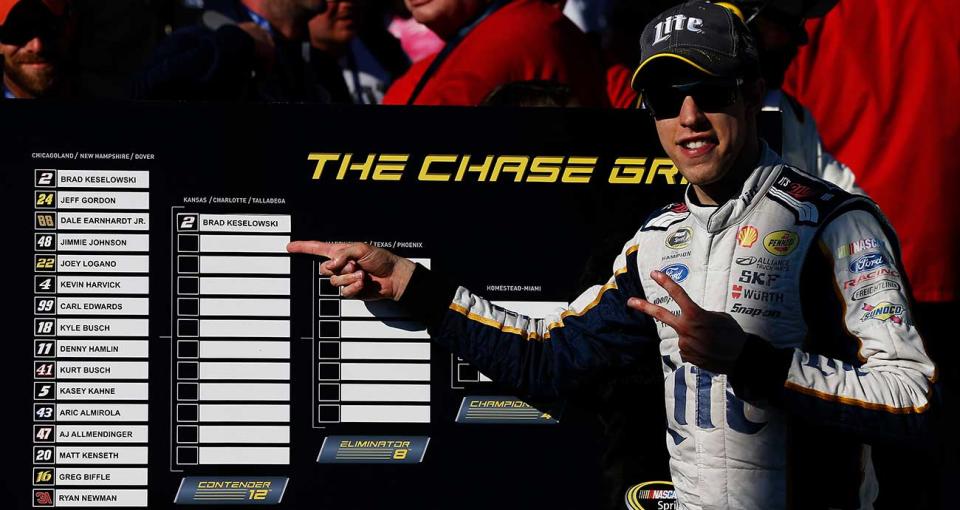“Shocked” was how Jimmie Johnson described it. In the wintertime before the 2014 season, he’d received a phone call from then-NASCAR chairman Brian France. Johnson’s sixth reign as Cup Series champion was barely two months old, but the way that he’d pursue title No. 7 was about to change.
France walked him through the details of the new format for the playoffs, then called the Chase for the NASCAR Sprint Cup. The introduction of eliminations every three races, culminating with a winner-take-all season finale for a four-driver field, was a substantial departure from the previous 10 years of determining a postseason champion from a 10-race aggregate of points. It marked a new era, one Johnson wasn’t quite ready to process.
“It just caught me off guard and shocked me,” Johnson told the Associated Press, “and I told Brian when he called me, ‘Just give me a minute to adjust, because I’m on my heels.’ ”
Ten years of postseason grids, championship marches, unpredictable eliminations, and pressure-packed moments later, the Cup Series Playoffs is ready to enter its second decade. During the two-week Olympic break, NASCAR.com will reflect with a special series looking back at those moments that have defined the era, then look ahead as this year’s final four regular-season races tee up the next edition of the elimination procedure for the Bill France Cup.
RELATED: Vote for top moment in elimination era
Those memories start with some history, a retrospective about how the system was received, and how it has evolved and altered the industry’s approach to competition.
“We’re furthering how we refine and how we approach this as a team — all of our cars — so it’s been interesting, and it’s still changing,” said Team Penske competition director Travis Geisler, noting how each evolutionary moment has forced his organization — winners of the last two Cup Series championships — to adapt. “The recipe is much like grandma cooks. It’s just kind of a dash of this and a pinch of that.”
NASCAR had already made a sizable splash in 2004 when it adopted the first edition of the Chase. That structure placed top-performing competitors in their own exclusive class for title eligibility, a field that started at 10 drivers and then expanded to 12.
A decade with that format reached a turning point at the end of the 2013 season.
“We wanted to simplify our system,” said Steve O’Donnell, then NASCAR’s senior VP of racing operations and now its chief operating officer. “Sports fans across the country understand the idea of ‘playoffs,’ since every American sport features some kind of elimination format.”
Meetings prompted the change to a system that expanded the title-eligible field from 12 drivers to 16, but whittled that group by four drivers at each checkpoint in the 10-race stanza. Consistency was still a factor, but wins also gained importance — both as a gateway to playoff eligibility and an automatic advancement once the playoffs began.
NASCAR had dabbled with eliminations before, with a format that shaved cars from the running order in the annual non-points All-Star Race in 2002-03, but never with the stakes of the premier series championship on the line. That prompted O’Donnell to make a direct plea to the stock-car faithful at the format’s introduction on Jan. 30, 2014.
“There are passionate fans out there, and I hear them as well. Those who may not like this are very passionate about it,” O’Donnell said. “What I would say is, instead of dismissing them, we very much value their opinion. It’s OK. But I’d say, ‘Give this a chance, because it’s still the sport you love. We’re just going to take the sport you love and elevate it that much more.’ ”
Some of those predictions for a riveting March Madness or playoff hockey atmosphere in the autumn sunset of the NASCAR season came true in a rollicking nine-race run to Homestead. Aggression, controversy and motivation ran high, resulting in a Championship 4 quartet of Kevin Harvick, Denny Hamlin, Joey Logano and Cinderella sensation Ryan Newman, who converted a desperation move in the next-to-last race to make the final cut.
Drivers making the media rounds that week seemed to warm up to the format, even after running through that first elimination gauntlet.

“This move was about growing the sport and making it sustainable for years to come,” The Boston Globe quoted Brad Keselowski, a lightning rod for 2014’s polarizing moments who claimed his lone Cup title two years earlier in the waning seasons of the first Chase format. He was also the first winner under the new format, Sept. 14 of that year in the playoff opener at Chicagoland Speedway.
“If those metrics show that it’s working, then I’m a fan of it. My connection to the new NASCAR Sprint Cup Chase format is purely based on our fans’ reaction in a positive form. If that’s the case, then I’m supportive. I don’t have any other ties than that. I like tradition, but I’m not married to it. I’m more married to what our fans and partners think about it than anything else. Maybe the jury’s not fully in, but so far it’s come back very positive.”
Dale Earnhardt Jr. saw the benefits in an uptick in TV ratings and water-cooler chatter. He spoke highly of the format, even though it was unkind to him and his Hendrick Motorsports teammates during that inaugural season. He was ousted in the second round, and none of the organization’s four playoff-eligible drivers reached the Championship 4 finale.
“Did it work? I think it did work, because NASCAR wants more attention and more people talking, and I think that’s what happened,” Earnhardt said. “… We’ve gotten more publicity out of this year’s Chase than we’ve had in many years past.”
The next phase toward reaching the current postseason system came just three years after the first rollout. Competition officials broke each race into three stages, with points incentives awarded at each intermission. The bonuses also included playoff points for winning races and stages, and those extra tallies would carry over when the standings were reset after each playoff interval — a reward for performance in both the regular season and postseason.
The shift also came with a name change — “Chase” was dropped for the more recognizable “Playoffs,” a nod to other big-league sports. “This was a situation of the entire industry coming together for the betterment of the sport,” O’Donnell said. “We worked closely with everyone from teams and drivers to our broadcast and (manufacturer) partners. It was important that everybody felt invested in where we were going.”
Back in the current day, Joey Logano weighs the merits of the playoff system with a discerning eye — even for a driver who has won two Cup Series championships since the advent of stages and the elimination era. In the first year of stages, the unpredictability snared him; Logano missed the postseason altogether.
“It’s just creating more do-or-die moments where you weren’t going into the final race of the year knowing who was going to win the championships, and drivers go in there, just cruise-control for the race, don’t wreck, get through, win the championship,” Logano said at Indianapolis Motor Speedway. “So that was one of the things they wanted to get away from, but then there’s also, how do you make every race more important where you don’t just win a race and then you’re in and then you cruise-control the rest of the year until the playoffs start with no advantage, or you win 10 races during the season and you’re seeded the same as the guy who won one. That’s not fair, either. So that’s where I think all these ideas came up in those meetings.”
Still, the concept was considered a radical departure from the status quo for decades.
“It is, but I have no doubt in my mind it’s right,” Logano said. “I think it’s been one of the best things for the sport. There’s always going to be somebody that doesn’t like it and they’re going to have a loud voice, because people listen to people who don’t like things more than people who like things. People usually don’t give compliments; they just complain. So you’re going to hear that more often, but I think in general, it’s been good for the sport.”
Some 10 years after the idea was hatched, teams aren’t quite as taken aback as Johnson was in that first explanatory phone call. The skepticism has since faded, even if the ferocity of the postseason structure hasn’t.
“I enjoy the intensity level, the pressure level that kind of ratchets up, and it does break up what otherwise is a very long season,” Geisler said. “I think it makes sense to have a break point somewhere in there. Initially, it was more just the normal human response: You don’t like change and the point champion is the whole season — maybe the relics of how we all have grown up racing. But now that we’re in this, I can see where it really does generate some exciting racing, some exciting scenarios that you never know how it’s all going to come together, but it always seems like those last couple (races) are just tooth and nail. That’s what we’re supposed to be doing.”
Source Agencies

